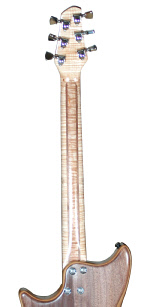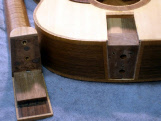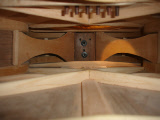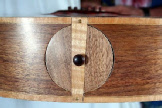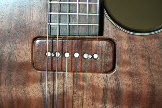I genarally laminate my necks. This gives me the best control of the grain orientation and provides an opportunity for decorative elements. The example to the right is a lamination with curly maple and walnut, which ties into walnut top and back laminations on the body.
I primarily use bolt on necks. For acoustics, I exclusively use bolt-
I use a joint on my acoustic guitars that allows for adjustment of the neck angle. This allows for fine adjustment of string action without removing the neck. For the conventional tapered dovetail (such as used by Martin), a neck reset is a major (and costly) repair. Even for the conventional bolt on joint (such as introduced by Taylor and widely adopted elsewhere), the fingerboard is glued to the top, and, therefore, still requires a fair effort to reset the neck. My necks are held in place with bolts through the head block and threaded inserts in the neck heel. Angle adjustments are made via set screws threaded into the head block bearing against steel inserts in the neck heel.
The entire neck is reinforced with carbon fiber rods that extend into the fingerboard support. In conventional construction, the end of the fingerboard is glued to the top. This requires additional braces in the upper bout as support. My guitars do not require these braces; this allows increased vibration and sound generation in this part of the top.
This is the view of the inside of a guitar, looking from the rear access port toward
the neck block. What we see here is a fairly conventional X-
Note that this is the same guitar pictured above before the cutout in the top was made for the fingerboard extension.
I incorporate rear access ports into the heal block of my acoustic guitars. This
serves several purposes. It allows adjustment of the neck without removing the strings.
It allows easy access for fine tuning braces after assembly, repairs, and installation
of a bridge-
JeStone Pickups
I use commercially made pickups for most of my electric guitars. There are many high quality commercial pickups to choose from, and custom winding pickups is fairly time consuming and tedious. I do, however, custom wind pickups for special projects. The picture at the right shows such an example. For this guitar I wanted a fat single coil pickup with more beef than the standard stratocaster and telecaster style pickups. I considered using P90’s, but the pole spacing is too narrow. I made a strat/P90 hybrid that fits into P90 form factor. I used strat style alnico cylinder magnets and wound them with 9000 and 10,000 turns (neck and bridge pickup, respectively). I could not use standard plastic covers, so I made walnut covers to blend into the guitar top. These turned out just as I had hoped: they have some of the growl of a P90, but with the bell like ring of a strat pickup.
Other Features
Click on images to enlarge.
